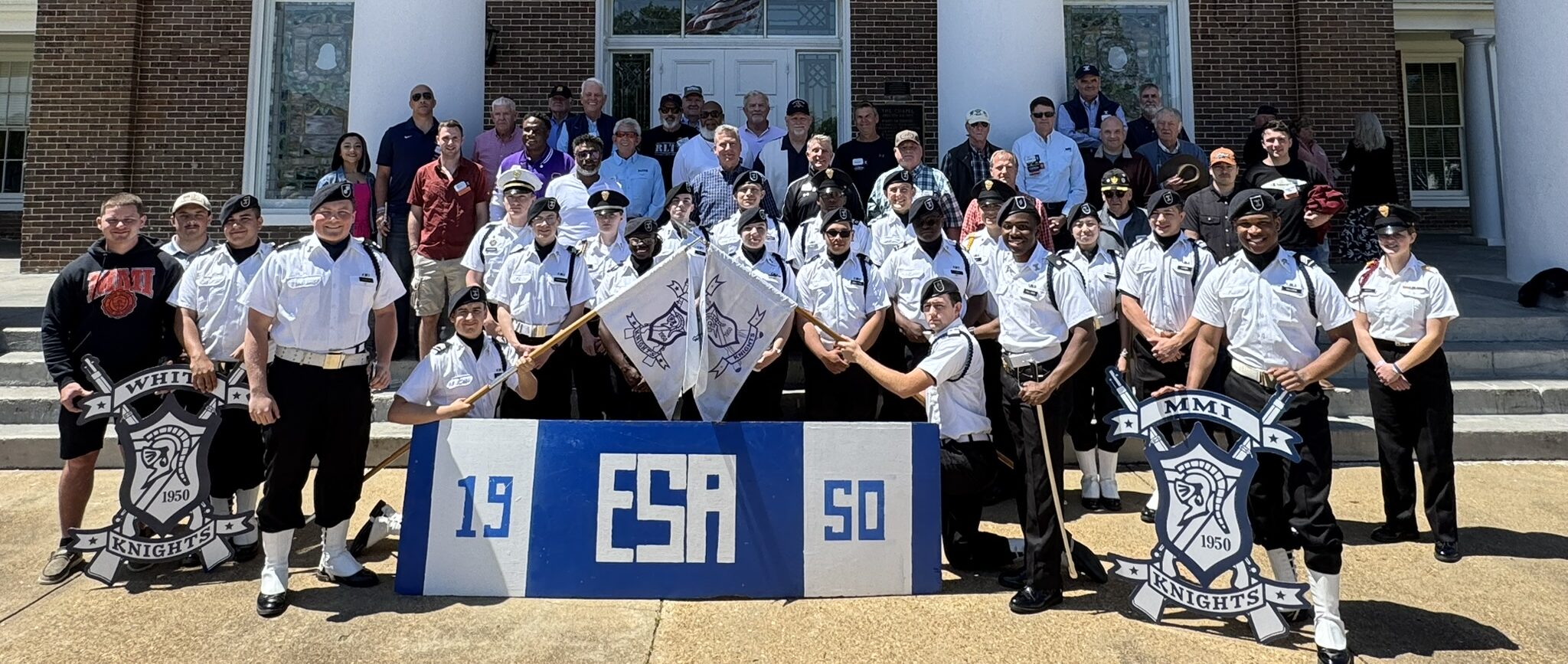White Knights 75th Anniversary
The White Knights celebrated their 75th Anniversary Reunion Dinner on April 12, 2025 in the Special Event Room, MMI Dining Hall.

WHITE KNIGHTS HISTORY
Marion Military Institute Archives
Monday, October 12, 2009
Stylin’ With The White Knights
In the fall of 1950, William “Bill” Walker, a veteran of the U. S. Army, enrolled at Marion Military Institute. During the occupation of Berlin, Germany, after World War II, Walker had served in the “Berlin Honor Guard,” a crack U. S. Army drill team under General Lucius D. Clay’s command. With Berlin partitioned by the Allied countries of the United Kingdom, France, and the United States (West Berlin), and the Soviets in East Berlin, “The Berlin Honor Guard” had to be the “best of the best,” the “elite” among all the international military units present. The unit worked diligently every day toward achieving that goal.
When Bill Walker arrived at MMI and was assigned to Old South Barracks (now Lovelace Hall), he told his cadet company commander and platoon leader – Cadets Steve Finch and Gene Hyche – about his drill team experience in Germany. He also offered to assist with the company’s drill. Following protracted discussions, the idea gelled with these three cadets to organize and develop a similar crack precision drill team at MMI, one that would also strive to be the “best of the best” among the nation’s military colleges and schools.
After circulating the idea throughout the Corps of Cadets for interest, Cadets Finch and Hyche approached the Commandant, COL Paul B. Robinson (later, MMI president) with their plan. Robinson told them that Finch was going to be the Cadet Battalion Commander, thus, he would not have time to participate in the drill team. Finally, after refining their plan, COL Robinson approved it.
When tryouts were held, some 50-60 cadets were expected to participate. However, nearly a third of the Corps showed up, each cadet vying to prove that he was the best. During tryouts, they drilled 3-5 days a week, 2-4 hours a day for more than two weeks. When the smoke finally cleared, more than 40 cadets were selected for the first unit which took the name, “The White Knights.” Cadets Gene Hyche and Bill Walker became the co-founders in 1950, with Hyche serving as the first White Knights Commander. The White Knights were intent on stylin,’ as Cadet Hyche called it.
COL Ellis Marsh of the ROTC Department assigned Sgt. Ralph Glendening, a veteran of the 82nd Airborne Division and of the Normandy Invasion airborne assault, to oversee the White Knights. Army Sgt. Tom Hamilton, a Canadian and a former British Commando in World War II, was assigned to assist Glendening. Later, CPT Ben Marshall, an Infantry officer who had been a fighter pilot in World War II, was appointed advisor.
Uniforms for the White Knights included white helmets, white ascots, white gloves, and white leggings. The standard M-1 rifle, assigned to the Corps, was the first rifle used. However, when COL James T. Mufee II, MMI’s president, was approached for $1,000 to outfit the unit, he denied the request because Murfee doubted the longevity of the White Knights past more than a couple of years or so. Gradually, however, he warmed to the unit and became a proud supporter.
The first performance of the White Knights took place at a football game in Bessemer, Alabama, but their first real test came when they performed at an Air Show at Maxwell Air Force Base in Montgomery – right after the performance of the crack Air Force Drill Team from Washington, D. C.! Having added taps to their boots, the White Knights performed a stunning silent drill which, by all accounts, “smoked” the Air Force Drill Team, a fact even acknowledged by their advisor! The White Knights were stylin’ now!
Over the years, the White Knights established an enviable state and national reputation as a precision drill team of the first order. Among their numerous appearances representing Marion Military Institute and the State of Alabama, the White Knights performed at the Indianapolis 500, the Sugar Bowl, and in the United States Air Force Academy Drill Competition. They also make frequent instate appearances at the annual Veterans Day Parade in Birmingham, and at the Mardi Gras in Mobile.
